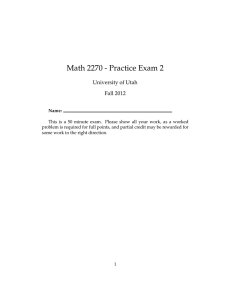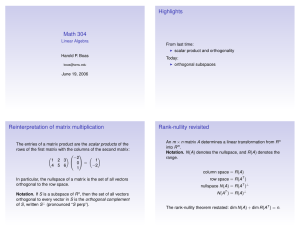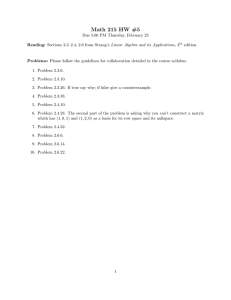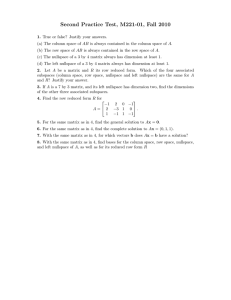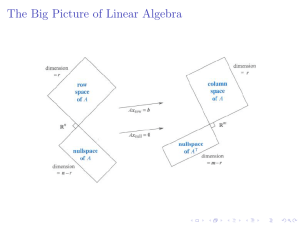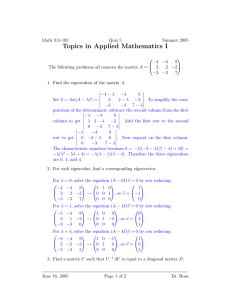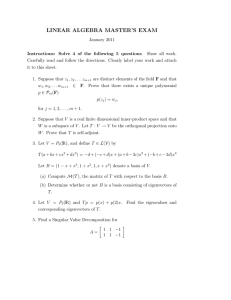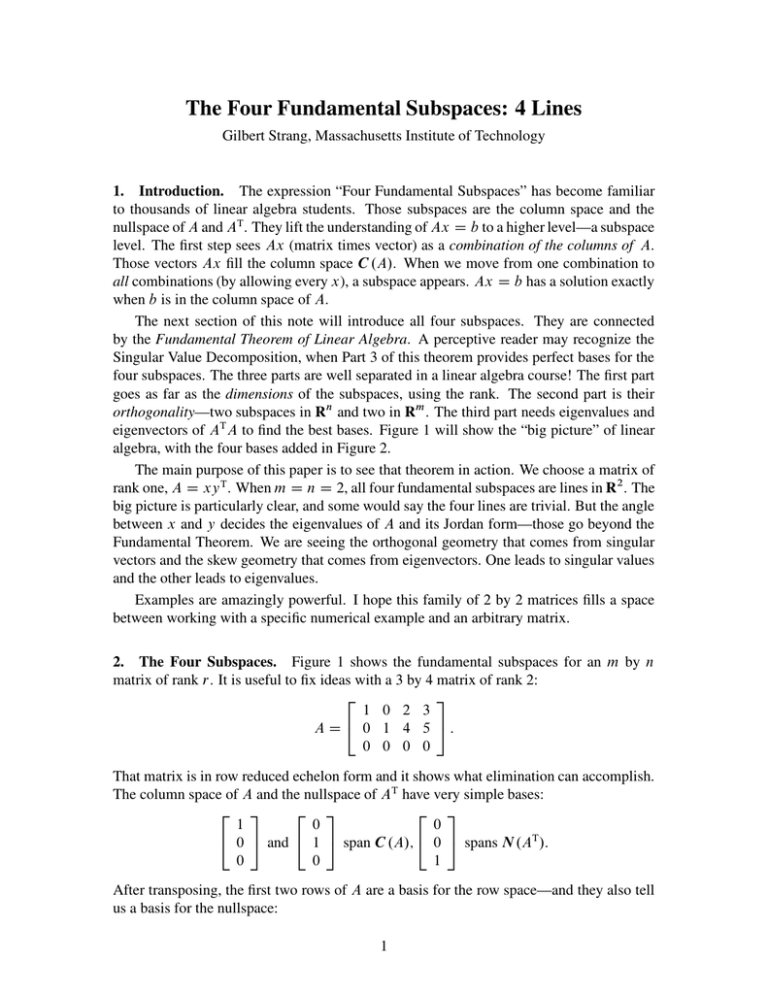
The Four Fundamental Subspaces: 4 Lines
Gilbert Strang, Massachusetts Institute of Technology
1. Introduction. The expression “Four Fundamental Subspaces” has become familiar
to thousands of linear algebra students. Those subspaces are the column space and the
nullspace of A and AT . They lift the understanding of Ax D b to a higher level—a subspace
level. The first step sees Ax (matrix times vector) as a combination of the columns of A.
Those vectors Ax fill the column space C .A/. When we move from one combination to
all combinations (by allowing every x), a subspace appears. Ax D b has a solution exactly
when b is in the column space of A.
The next section of this note will introduce all four subspaces. They are connected
by the Fundamental Theorem of Linear Algebra. A perceptive reader may recognize the
Singular Value Decomposition, when Part 3 of this theorem provides perfect bases for the
four subspaces. The three parts are well separated in a linear algebra course! The first part
goes as far as the dimensions of the subspaces, using the rank. The second part is their
orthogonality—two subspaces in Rn and two in Rm . The third part needs eigenvalues and
eigenvectors of AT A to find the best bases. Figure 1 will show the “big picture” of linear
algebra, with the four bases added in Figure 2.
The main purpose of this paper is to see that theorem in action. We choose a matrix of
rank one, A D xy T . When m D n D 2, all four fundamental subspaces are lines in R2 . The
big picture is particularly clear, and some would say the four lines are trivial. But the angle
between x and y decides the eigenvalues of A and its Jordan form—those go beyond the
Fundamental Theorem. We are seeing the orthogonal geometry that comes from singular
vectors and the skew geometry that comes from eigenvectors. One leads to singular values
and the other leads to eigenvalues.
Examples are amazingly powerful. I hope this family of 2 by 2 matrices fills a space
between working with a specific numerical example and an arbitrary matrix.
2. The Four Subspaces. Figure 1 shows the fundamental subspaces for an m by n
matrix of rank r. It is useful to fix ideas with a 3 by 4 matrix of rank 2:
2
3
1 0 2 3
A D 4 0 1 4 5 5:
0 0 0 0
That matrix is in row reduced echelon form and it shows what elimination can accomplish.
The column space of A and the nullspace of AT have very simple bases:
2 3
2 3
2 3
1
0
0
4 0 5 and 4 1 5 span C .A/; 4 0 5 spans N .AT /:
0
0
1
After transposing, the first two rows of A are a basis for the row space—and they also tell
us a basis for the nullspace:
1
3
2
0
1
6 1
6 0 7
6 7 and 6
4 4
4 2 5
5
3
2
3
2
7
6
7 span C .AT /; 6
5
4
2
3
2
6
4 7
7 and 6
4
1 5
0
3
3
5 7
7 span N .A/:
0 5
1
The last two vectors are orthogonal to the first two. But these are not orthogonal bases.
Elimination is enough to give Part 1 of the Fundamental Theorem:
The column space and row space have equal dimension r D rank
The nullspace N .A/ has dimension n r; N .AT / has dimension m
Part 1
r
That counting of basis vectors is obvious for the row reduced rref.A/. This matrix has r
nonzero rows and r pivot columns. The proof of Part 1 is in the reversibility of every
elimination step—to confirm that linear independence and dimension are not changed.
C .AT /
C .A/
Row space
all AT y
dim r
dim n
R
n
Column space
all Ax
Perpendicular
x T .AT y/ D 0
Perpendicular
y T .Ax/ D 0
r
x in
Nullspace
Ax D 0
N .A/
dim r
Rm
dim m
y in
T
Nullspace of A
AT y D 0
N .AT /
r
Figure 1: Dimensions and orthogonality for any m by n matrix A of rank r.
Part 2 says that the row space and nullspace are orthogonal complements. The orthogonality comes directly from the equation Ax D 0. Each x in the nullspace is orthogonal to
each row:
2
32 3 2 3
.row 1/
0
x is orthogonal to row 1
4
5
4
5
4
5
x D Ax D 0
.row m/
0
x is orthogonal to row m
The dimensions of C .AT / and N .A/ add to n. Every vector in Rn is accounted for, by
separating x into xrow C xnull .
For the 90ı angle on the right side of Figure 1, change A to AT . Every vector b D Ax
in the column space is orthogonal to every solution of AT y D 0. More briefly, .Ax/T y D
x T .AT y/ D 0.
Part 2
C .AT / D N .A/?
N .AT / D C .A/?
Orthogonal complements in Rn
Orthogonal complements in Rm
2
Part 3 of the Fundamental Theorem creates orthonormal bases for the four subspaces.
More than that, the matrix is diagonal with respect to those bases u1 ; : : : ; un and v1 ; : : : ; vm .
From row space to column space this is Avi D i ui for i D 1; : : : ; r. The other basis vectors are in the nullspaces: Avi D 0 and AT ui D 0 for i > r. When the u’s and v’s
are columns of orthogonal matrices U and V , we have the Singular Value Decomposition
A D U †V T :
3
2
3 2
32
1 :
Part 3
AV D A 4 v1 vr vn 5 D 4 u1 ur um 5 4
r 5 D U †:
The v 0 s are orthonormal eigenvectors of AT A, with eigenvalue i2 0. Then the eigenvector matrix V diagonalizes AT A D .V †T U T /.U †V T / D V .†T †/V T . Similarly U
diagonalizes AAT .
When matrices are not symmetric or square, it is AT A and AAT that make things right.
This summary is completed by one more matrix: the pseudoinverse. This matrix A C
inverts A where that is possible, from column space back to row space. It has the same
nullspace as AT . It gives the shortest solution to Ax D b, because AC b is the particular
solution in the row space: AAC b D b. Every matrix is invertible from row space to column
space, and AC provides the inverse:
Pseudoinverse
A C ui D
vi
i
for
i D 1; : : : ; r:
Figure 2: Orthonormal bases that diagonalize A (3 by 4) and AC (4 by 3).
3
Figure 2 shows the four subspaces with orthonormal bases and the action of A and A C .
The product AC A is the orthogonal projection of Rn onto the row space—as near to the
identity matrix as possible. Certainly AC is A 1 when that inverse exists.
3. Matrices of Rank One. Our goal is a full understanding of rank one matrices
A D xy T . The columns of A are multiples of x, so the column space C .A/ is a line.
The rows of A are multiples of y T , so the row space C .AT / is the line through y (column
vector convention). Let x and y be unit vectors to make the scaling attractive. Since all the
action concerns those two vectors, we stay in R2 :
x1 y 1 x1 y 2
T
A D xy D
: The trace is x1 y1 C x2 y2 D x T y:
x2 y 1 x2 y 2
The nullspace of A is the line orthogonal to y. It is in the direction of y ? D .y2 ; y1 /.
The algebra gives Ay ? D .xy T /y ? D 0 and the geometry is on the left side of Figure 3.
The good basis vectors are y and y ? . On the right side, the bases for the column space of
A and the nullspace of AT D yx T are the orthogonal unit vectors x and x ? .
Oy
?
x]
N .AT /
y
:
T
C .A /
x+?
N .A/
C .A/
Figure 3: The fundamental subspaces for A D xy T are four lines in R2 .
4. Eigenvalues of xy T . The eigenvalues of A were not mentioned in the Fundamental
Theorem. Eigenvectors are not normally orthogonal. They belong to the column space and
the nullspace, not a natural pair of subspaces. One subspace is in R m , one is in Rn , and
they are comparable (but usually not orthogonal) only when m D n. The eigenvectors of
the singular 2 by 2 matrix A D xy T are x and y ? :
Eigenvectors
Ax D .xy T /x D x.y T x/
and
Ay ? D .xy T /y ? D 0:
The new and crucial number is that first eigenvalue 1 D y T x D cos . This is the trace
since 2 D 0. The angle between row space and column space decides the orientation in
Figure 3. The extreme cases D 0 and D =2 produce matrices of the best kind and the
worst kind:
Best
cos D 1 when x D y:
Then A D xx T
Worst
cos D 0 when x D y ? :
Then A D y ? y T has trace zero with D 0; 0
is symmetric with
D 1; 0
“Worst” is a short form of “nondiagonalizable”. The eigenvalue D 0 is repeated and the
two eigenvectors x and y ? coincide when the trace y T x is zero. At that point A D xy T
4
cannot be similar to the diagonal matrix of its eigenvalues (because this will be the zero
matrix). The right choice of Q 1 AQ will produce the Jordan form in this extreme case
when x and y are orthonormal:
T T 0 1
x
x
T
0 x D
x y D
xy
J D
yT
0 0
yT
Jordan chose the best basis (x and y) to put xy T in that famous form, with an offdiagonal 1 to signal a missing eigenvector. The SVD will choose two different orthonormal
bases to put xy T in its diagonal form †.
5. Factorizations of A D xy T . By bringing together three important ways to factor
this matrix, you can see the end result of each approach and how that goal is reached. We
still have kxk D kyk D 1 and y T x D cos . The end results are †; ƒ, and T .
1 0
T
D†
A. Singular Value Decomposition
U AV D
0 0
B. Diagonalization by eigenvectors
AS D
cos 0
0
0
Q AQ D
cos sin 0
0
S
C. Orthogonal triangularization
1
T
Dƒ
DT
The columns of U; V; S , and Q will be x; y; x ? , and y ? . They come in different orders!
A. In the SVD, the columns of U and V are orthonormal bases for the four subspaces.
Figure 3 shows u1 D x in the column space and v1 D y in the row space. Then Ay D
.xy T /y correctly gives x with 1 D 1. The nullspace bases are u2 D x ? and v2 D y ? .
Notice the different bases in U and V , from the reversal of x and y:
T T 1 0
T
?
T
?
?
U AV D x x
xy
y y D x x
x 0 D
D†
0 0
The pseudoinverse of xy T is yx T . The norm of A is 1 D 1.
B. In diagonalization, the eigenvectors of A D xy T are x and y ? . Those are the columns
of the eigenvector matrix S , and its determinant is y T x D cos . The eigenvectors of
AT D yx T are y and x ? , which go into the rows of S 1 (after division by cos ).
T T 1
cos 0
1
?
T
?
S AS D
Dƒ
y x
xy
x y
D y 0
x 0 D
0
0
cos This diagonalization fails when cos D 0 and S is singular. The Jordan form jumps from
ƒ to J , as that off-diagonal 1 suddenly appears.
C. One of the many useful discoveries of Isaac Schur is that every square matrix is unitarily
similar to a triangular matrix:
Q AQ D T
with
5
Q Q D I:
His construction starts with the unit eigenvector x in the first column of Q. In our 2 by 2
case, the construction ends immediately with x ? in the second column:
T T cos sin y
x
?
?
T
T
DT
x x D
x x D
Q AQ D
xy
0
0
0T
x ?T
This triangular matrix T still has norm 1, since Q is unitary. Numerically T is far more
stable than the diagonal form ƒ. In fact T survives in the limit cos D 0 of coincident
eigenvectors, when it becomes J .
Note The triangular form T is not so widely used, but it gives an elementary proof of a
seemingly obvious fact: A random small perturbation of any square matrix is almost sure
to produce distinct eigenvalues. What is the best proof?
More controversially, I wonder if Schur can be regarded as the greatest linear algebraist
of all time?
Summary The four fundamental subspaces, coming from A D xy T and from AT D yx T ,
are four lines in R2 . Their directions are given by x; x ? ; y; and y ? . The eigenvectors of A
and AT are the same four vectors. But there is a crucial crossover in the pictures of Figures
1-2-3. The eigenvectors of A lie in its column space and nullspace, not a natural pair. The
dimensions of the spaces add to n D 2, but the spaces are not orthogonal and they could
even coincide.
The better picture is the orthogonal one that leads to the SVD.
References
These are among the textbooks that present the four subspaces.
1. David Lay, Linear Algebra and Its Applications, Third edition, Addison-Wesley (2003).
2. Peter Olver and Chehrzad Shakiban, Applied Linear Algebra, Pearson Prentice-Hall
(2006).
3. Theodore Shifrin and Malcolm Adams, Linear Algebra: A Geometric Approach,
Freeman (2001).
4. Gilbert Strang, Linear Algebra and Its Applications, Fourth edition, Cengage (previously Brooks/Cole) (2006).
5. Gilbert Strang, Introduction to Linear Algebra, Third edition, Wellesley-Cambridge
Press (2003).
6

